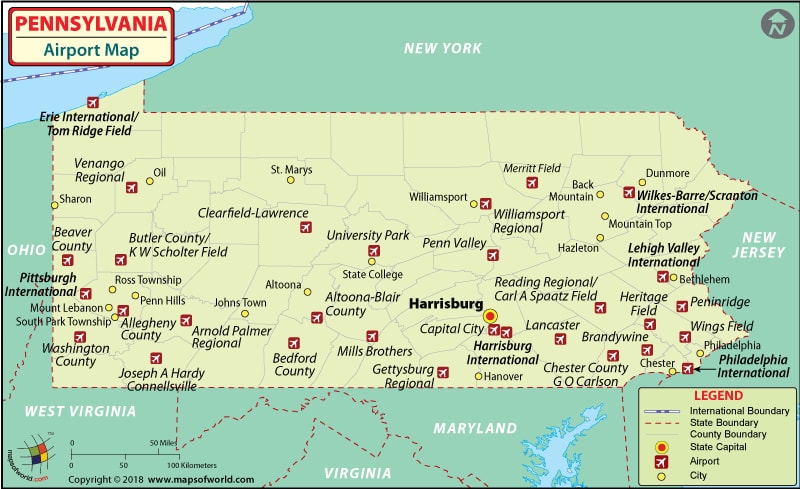Airports in Pennsylvania: An Overview
Pennsylvania, known for its keystone location, offers a variety of airports catering to different needs. From international hubs to regional airports, Pennsylvania’s airports support both passenger travel and cargo operations.
Philadelphia International Airport (PHL)
Philadelphia International Airport, the largest airport in Pennsylvania, serves as a major hub for domestic and international flights. Located just seven miles from downtown Philadelphia, it provides an essential gateway to the Northeast United States. PHL handles approximately 30 million passengers annually. It supports numerous airlines, including American Airlines, which has a major hub here. The airport features several terminals connected by a shuttle bus service. Travelers can find various amenities such as dining, shopping, and lounges within its terminals.
Pittsburgh International Airport (PIT)
This airport offers a strategic location in Western Pennsylvania. Pittsburgh International serves as a critical regional hub, handling millions of passengers each year. The airport is situated about 20 miles west of downtown Pittsburgh. The terminal layout is comprised of a landside terminal and an airside terminal. Pittsburgh International provides services from multiple airlines and offers both domestic and limited international flights. Travelers can enjoy various services, including retail options, dining, and business facilities within the airport’s design.
Harrisburg International Airport (MDT)
Located in Middletown, Harrisburg International Airport serves Pennsylvania’s capital region. It accommodates over a million passengers annually. The airport provides quick access to the Pennsylvania state government and nearby cities. MDT features one modern terminal and a wide array of services for travelers. It operates several airlines offering connections across the United States, supporting both domestic passenger flights and cargo operations.
Lehigh Valley International Airport (ABE)
Serving the Allentown area, Lehigh Valley International Airport stands as a crucial regional airport in Pennsylvania. The airport is located in Hanover Township, which lies to the northeast of Allentown. ABE manages a fair number of commercial flights, primarily offering domestic service. Various airlines operate from here, with destinations mainly across the eastern United States. The airport’s facilities include parking, car rentals, dining options, and general aviation services.
Wilkes-Barre/Scranton International Airport (AVP)
Situated between the cities of Wilkes-Barre and Scranton, AVP provides essential air service to Northeastern Pennsylvania. The airport includes a single terminal that hosts commercial passenger airlines. It provides flights to key destinations across the United States. This supports both business and leisure travel needs of the region. The terminal offers a range of conveniences such as passenger services, dining, and free Wi-Fi.
Erie International Airport (ERI)
Erie International is positioned in the northwest corner of Pennsylvania. It offers essential services to Erie and surrounding areas. ERI provides scheduled passenger service via several airlines, connecting primarily with larger hubs for broader access. The airport facilities support travel with conveniences such as parking, car rentals, and ground transportation services. It plays a crucial role in regional connectivity.
Arnold Palmer Regional Airport (LBE)
Named after the famous golfer, Arnold Palmer Regional Airport serves Westmoreland County and the Greater Pittsburgh area. It is known for providing low-cost airline services to vacation destinations. The airport, located in Latrobe, Pennsylvania, features a passenger terminal designed for efficiency and convenience. It handles smaller loads compared to major airports but plays a significant role in regional air travel. Ground services and parking facilities support passenger flow effectively.
Reading Regional Airport (RDG)
This airport serves the city of Reading and Berks County. Reading Regional does not offer scheduled commercial service but supports general aviation, flight training, and maintenance facilities. The airport holds events like airshows and provides services tailored to private pilots and aviation companies. It plays a vital role in local economy by supporting business travel and aviation-related industries.
University Park Airport (SCE)
Located near State College, University Park Airport primarily serves Penn State University and central Pennsylvania. It features a comfortable terminal with facilities aimed at providing convenience to travelers. The airport offers scheduled flights through domestic airlines, providing access to major hubs. University Park plays a significant role in supporting academic-related travel and community aviation needs.
Allegheny County Airport (AGC)
This airport serves as Pittsburgh’s secondary airport, focused primarily on general aviation. Allegheny County Airport is among the oldest airports in the region. Located in West Mifflin, it offers core services for private and corporate flights. Facilities include hangars, maintenance services, and amenities for pilots and passengers alike. It complements Pittsburgh International by alleviating some aviation traffic from the area.
Wings Field (LOM)
Wings Field, strategically positioned in Blue Bell, caters to the executive and general aviation sector. Known for its rich history, it once served as an airmail stop in the early aviation days. Today, the field accommodates business travelers and aviation enthusiasts. It offers hangar space, flight training, and private charter services. Wings Field plays an integral role in facilitating business aviation within Eastern Pennsylvania.
Johnstown–Cambria County Airport (JST)
Johnstown Airport is located in Pennsylvania’s western region. It provides essential air services for the Cambria County area. Offering commercial flights through regional airlines, it connects to larger hubs. The airport maintains a range of services to aid passengers and includes facilities like parking, rental cars, and a modest passenger terminal.
Conclusion
While this overview covers some of the most significant airports in Pennsylvania, it’s important to note the numerous other smaller regional and municipal airports throughout the state. Each plays a distinct role in shaping the aviation landscape of Pennsylvania, ensuring connectivity for millions of passengers annually.
The Pilot’s Handbook of Aeronautical Knowledge is an essential reference for aviation students.
